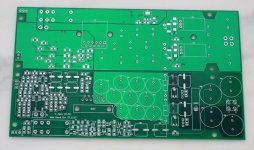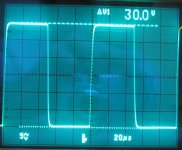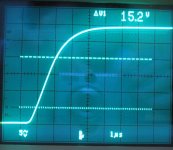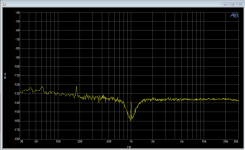I have received the new boards, now soldering and assembling the amp. Read my blog here http://www.s-audio.com/
Attachments
Yep.LM3886 is in open-loop when the output relay open. Is the chip muted at that time?
Square signal without input/output filters:
PS. The input filter is phase linear too (Bessel's).
PS. The input filter is phase linear too (Bessel's).
Attachments
Last edited:
I am sorry Spasticteapot, no more boards left. I'll let you know if/when I will make them again.
Dear Nickolay,
Thanks for sharing. Very interesting. Please allow me to ask some questions out of interest.
-How does it sound in comparison with a basic chip design?
-Why you choose for a ground-plane over star grounding?
-How is clipping behavior? If the chip clips, the driver opamp will try to compensate, but it can't. Don't you get high over and undershoot?
-What is the chips get into thermal protection, won't the first chip get driven into clipping?
With kind regards,
Bas
Thanks for sharing. Very interesting. Please allow me to ask some questions out of interest.
-How does it sound in comparison with a basic chip design?
-Why you choose for a ground-plane over star grounding?
-How is clipping behavior? If the chip clips, the driver opamp will try to compensate, but it can't. Don't you get high over and undershoot?
-What is the chips get into thermal protection, won't the first chip get driven into clipping?
With kind regards,
Bas
Last edited:
Hello Bas,
It is possible to fix it using non-linear feedback technique, but I do not see a simple solution for LM3886 because of it's Spike protection.
On the other hand I do not see why should I fix it but to see a nice picture on the scope... I guess it is easier and better to implement clip indicator.
PS. Actually one of this amps is on for 24 hour per day almost 1.5 years. No problems at all so far.
It sounds different: much more detailed and transparent, bass is very articulate and deep. However I believe I should have no trust in this because I am a designer of this amp 🙂. So my advise is to ask somebody else...How does it sound in comparison with a basic chip design?
No, it looks like a plane, but is rather a star with multiple planes. You can see that all planes are connected at the speaker ground pin.Why you choose for a ground-plane over star grounding?
Clipping behavior is not excellent - you right. I posted some pictures from my scope with clipping here, you can take a look. It is sticky and can a little oscillate (with no output filter), but this oscillation is very limited.How is clipping behavior? If the chip clips, the driver opamp will try to compensate, but it can't. Don't you get high over and undershoot?
It is possible to fix it using non-linear feedback technique, but I do not see a simple solution for LM3886 because of it's Spike protection.
On the other hand I do not see why should I fix it but to see a nice picture on the scope... I guess it is easier and better to implement clip indicator.
Yes, it will, but nothing bad is happening.What is the chips get into thermal protection, won't the first chip get driven into clipping?
PS. Actually one of this amps is on for 24 hour per day almost 1.5 years. No problems at all so far.
Dear Nickolay,
Thank you for your responses. I believe firmly in your concept. My own experience with nested feedback chip designs are the same as yours. Extremely detailed and bass so tight that it is shocking.
One last questions. I see your PCB layout, excellent! Did you ever tried to use one whole ground-plane instead? Maybe in attempt to reach a even lower ground impedance.
There is of course not "Right or wrong" in this and many concepts will work. Lately I am studying a lot about ground-planes, and I wonder if there are even more benefits with using a whole ground-plane for the whole board without interruption.
Again congrats with your great design! I think you would do the DIY community a big favor by producing and selling your boards.
With kind regards,
Bas
Thank you for your responses. I believe firmly in your concept. My own experience with nested feedback chip designs are the same as yours. Extremely detailed and bass so tight that it is shocking.
One last questions. I see your PCB layout, excellent! Did you ever tried to use one whole ground-plane instead? Maybe in attempt to reach a even lower ground impedance.
There is of course not "Right or wrong" in this and many concepts will work. Lately I am studying a lot about ground-planes, and I wonder if there are even more benefits with using a whole ground-plane for the whole board without interruption.
Again congrats with your great design! I think you would do the DIY community a big favor by producing and selling your boards.
With kind regards,
Bas
what about a limiter acting before the amp?Clipping behavior is not excellent - you right. I posted some pictures from my scope with clipping here, you can take a look. It is sticky and can a little oscillate (with no output filter), but this oscillation is very limited.
It is possible to fix it using non-linear feedback technique, but I do not see a simple solution for LM3886 because of it's Spike protection.
For preventing voltage clipping that's easy. Handling over-current (overload) induced clipping would be a bit trickier, but doable. Think something like an AGC. A servo which will sense both output voltage & current and progressively reduce the input voltage before the output approach the amplifier "hard" limits.
With such a thing you may prevent Spike from kicking in (...well, except for overheat conditions, which should not happen anyway). And you may get a very soft clipping too. 😎
The hard thing would be to do such a thing without swamping the exceptional THD & IMD figures of your amp. (...but you're the master here! 🙂 )
what about a limiter acting before the amp?
For preventing voltage clipping that's easy. Handling over-current (overload) induced clipping would be a bit trickier, but doable. Think something like an AGC. A servo which will sense both output voltage & current and progressively reduce the input voltage before the output approach the amplifier "hard" limits.
With such a thing you may prevent Spike from kicking in (...well, except for overheat conditions, which should not happen anyway). And you may get a very soft clipping too. 😎
The hard thing would be to do such a thing without swamping the exceptional THD & IMD figures of your amp. (...but you're the master here! 🙂 )
Dear Unixman,
Wel said. I solved this problem with almost the same solution but still slightly difference. Two parts:
1: I set up a comparator circuit that compares the output of the opamp with the output of the chipamp. In case when SPIKE kicks in there will be a difference between opamp out and chipamp out, and a relays get activated.
2: With a second comparator setup, I compare the output of the chip amp with a reference voltage subtracted from the amp power supply. I set the threshold a few dB before actually clipping. But subtract the reference voltage from the PSU line, in case of supply sagging from heavy loads, the threshold for the clipping indicator drops too.
3: A third option (which I only use in some bass applications) is a limiter circuit with an LDR that shunt on the input above a certain level.
With kind regards,
Bas
I prefer a soft clipping circuit on the input of the amplifier. By traking the short term avrage level of one of the power rails (and assuming that the other is its inverse) and using the knowlage of the closed loop gain the input of the amplifier can be attenuated before it causes the cliping event. Thurthermore by using a diode resistor arangment this can be a soft clip instead of hard limiting. As the soft clip circuit is normaly not connected it should have no impact on the distortion perfomance till the point of cliping wherupon it will cause even order distortion.
the circuit is called "klever klipper"
See PG 368 'designing audio power amplifiers' Bob Cordel, can't find the scematic on the web. If your interested I could scan the scematic for you.
the circuit is called "klever klipper"
See PG 368 'designing audio power amplifiers' Bob Cordel, can't find the scematic on the web. If your interested I could scan the scematic for you.
Some new measurements. Done on AP SYS 2722.
Attachments
Last edited:
dunno, i mean..back in some pretty old days if you could get your hand on -or build from discrete- a fast and precise wideband opamp, then limit the lil bastard to something that made sense, you before all these decent poweropamps where widespread and affordable and stuff- you sortha just put a hefty output stage in its feedback loop, with a minor gain of a few dBL, and..
you had something with specs close enough to this kindof amp, without the headaches of a verry complex feedback network. to some extent it was used simular to bob carver's amps, mainly to copy the sound of a given amplifier -well, it did not work that good, but ususally it could be shaped to match pretty mutch anything you liked-
power was an issue, the more gain you had in the output stage, the more it was likely to burst in flames or do something silly. but heck. back then speaker cabinets where large, and efficient. to the point where even few watts more than enough to rock the boat.
unlike many of todays space heaters, lol.
but i have to say the results are wounderfull, and the amplifer it self is interesting.
allmost falls to the too good to be true category.
but i'd guess this mindof amplifier is quite picky about build quality and probably has its hard moments.
not sure if it worth the headache vs an oldschool hybrid amplifier.
but i could be verry worng there.
you had something with specs close enough to this kindof amp, without the headaches of a verry complex feedback network. to some extent it was used simular to bob carver's amps, mainly to copy the sound of a given amplifier -well, it did not work that good, but ususally it could be shaped to match pretty mutch anything you liked-
power was an issue, the more gain you had in the output stage, the more it was likely to burst in flames or do something silly. but heck. back then speaker cabinets where large, and efficient. to the point where even few watts more than enough to rock the boat.
unlike many of todays space heaters, lol.
but i have to say the results are wounderfull, and the amplifer it self is interesting.
allmost falls to the too good to be true category.
but i'd guess this mindof amplifier is quite picky about build quality and probably has its hard moments.
not sure if it worth the headache vs an oldschool hybrid amplifier.
but i could be verry worng there.
- Home
- Amplifiers
- Chip Amps
- My ZD-50 ultralow distortion chipamp.




